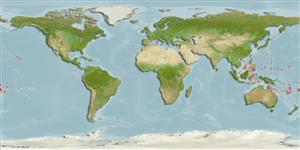>
Ovalentaria/misc (Various families in series Ovalentaria) >
Pomacentridae (Damselfishes) > Pomacentrinae
Etymology: Pomacentrus: Greek, poma, -atos = cover, operculum + Greek, kentron = sting (Ref. 45335); spilotoceps: Name from the Greek 'spilotos' for spotted and 'ceps' as short for head, referring to the orange or yellow spots on the head, its most characteristic markings..
More on author: Randall.
Environment: milieu / climate zone / depth range / distribution range
Sinh thái học
Biển Cùng sống ở rạn san hô; Mức độ sâu 0 - 5 m (Ref. 86942). Tropical
Sự phân bố
Các nước | Các khu vực của FAO | Các hệ sinh thái | Những lần xuất hiện | Point map | Những chỉ dẫn | Faunafri
South Pacific: Fiji and Tonga.
Bộ gần gũi / Khối lượng (Trọng lượng) / Age
Maturity: Lm ? range ? - ? cm
Max length : 7.8 cm SL con đực/không giới tính; (Ref. 54980)
Các tia vây lưng cứng (tổng cộng): 8; Các vây lưng mềm (tổng cộng): 14-15; Tia cứng vây hậu môn 2; Tia mềm vây hậu môn: 15; Động vật có xương sống: 26. This species is distinguished by the following characters: D XIII,14-15 (usually 15); A II,15; pectoral rays 18; tubed lateral line scales 17-18 (usually 18); total gill rakers 22-24; sub-orbital naked and the margin serrate; posterior edge of pre-orbital with a strong retrorse spine; body depth 1.95-2.1 in SL; longest dorsal spine 1.55-1.65 in HL; second anal spine 1.4-1.5 in HL. Colouration: yellowish brown, scale edges blackish; dull yellow to pale orange spots on opercle and anterior to and above pectoral fin base; two blue lines on side of snout crossing the upper lip; a small vertically elongate deep blue or black spot at the upper end of gill opening, a small black spot at upper pectoral fin base; in adults the ocellus posteriorly in lower half of dorsal fin may be present or absent; caudal fin abruptly yellowish (Ref. 124650).
Occurs on shallow coral reegs in calm areas (Ref. 124650). Diurnal species (Ref. 52881). Oviparous, distinct pairing during breeding (Ref. 205). Eggs are demersal and adhere to the substrate (Ref. 205). Males guard and aerate the eggs (Ref. 205).
Life cycle and mating behavior
Chín muồi sinh dục | Sự tái sinh sản | Đẻ trứng | Các trứng | Sự sinh sản | Ấu trùng
Oviparous, distinct pairing during breeding (Ref. 205). Eggs are demersal and adhere to the substrate (Ref. 205). Males guard and aerate the eggs (Ref. 205).
Randall, J.E., 2002. Two new damselfishes of the genus Pomacentrus from the south-west Pacific. aqua, J. Ichthyol. and Aquat. Biol. 5(4):167-176. (Ref. 124650)
IUCN Red List Status (Ref. 130435)
Threat to humans
Harmless
Human uses
Thêm thông tin
Age/SizeSự sinh trưởngLength-weightLength-lengthLength-frequenciesSinh trắc họcHình thái họcẤu trùngSự biến động ấu trùngBổ xungSự phong phúBRUVS
Các tài liệu tham khảoNuôi trồng thủy sảnTổng quan nuôi trồng thủy sảnCác giốngDi truyềnElectrophoresesDi sảnCác bệnhChế biếnNutrientsMass conversion
Các công cụ
Special reports
Download XML
Các nguồn internet
Estimates based on models
Preferred temperature (Ref.
123201): 25.1 - 29.4, mean 28.4 °C (based on 1179 cells).
Phylogenetic diversity index (Ref.
82804): PD
50 = 0.5000 [Uniqueness, from 0.5 = low to 2.0 = high].
Bayesian length-weight: a=0.02399 (0.01139 - 0.05051), b=2.98 (2.81 - 3.15), in cm total length, based on LWR estimates for this Genus-body shape (Ref.
93245).
Mức dinh dưỡng (Ref.
69278): 2.7 ±0.3 se; based on size and trophs of closest relatives
Thích nghi nhanh (Ref.
120179): Chiêù cao, thời gian nhân đôi của chủng quần tối thiểu là dưới 15 tháng (Preliminary K or Fecundity.).
Fishing Vulnerability (Ref.
59153): Low vulnerability (10 of 100).
Nutrients (Ref.
124155): Calcium = 428 [151, 957] mg/100g; Iron = 1.08 [0.54, 2.44] mg/100g; Protein = 17.4 [15.8, 18.8] %; Omega3 = 0.127 [0.050, 0.296] g/100g; Selenium = 9.29 [3.14, 25.41] μg/100g; VitaminA = 480 [88, 2,512] μg/100g; Zinc = 4.35 [2.39, 7.67] mg/100g (wet weight);
